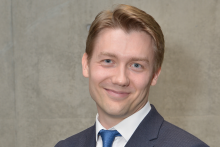‘Lasers are fascinating tools’
Rubicon grant from NWO
Igor Milov, a postdoc within the UT’s Industrial Focus Group XUV Optics, has received a Rubicon grant from the Dutch Research Council (NWO). With his grant he will spend two years in Hamburg, Germany, doing research on how materials react to strong laser pulses.

RUBICON
A Rubicon grant allows young, promising scientists to conduct research at a research institute abroad for up to 24 months. 76 young researchers submitted a proposal in this round, of which only 24 were granted. Two more rounds of grants will follow this year; in total, NWO is funding about 60 researchers. A total of 7 million euros is distributed annually among the young researchers. The height of their grant depends on the length of their stay and the country they go to.
According to Milov, he reacted 'very happy' to the news about the Rubicon grant. 'It's my first personal grant. I was quite nervous. Due to a hack at NWO, the deadlines were postponed. That was a disappointment on the one hand, but it also gave me more time to polish my proposal.’
Milov's awarded research proposal focuses on so-called 'pulsed lasers'. ‘Everyone knows what lasers are,' the young researcher begins. ‘And they are now used everywhere, think for example of eye surgery. But pulsed lasers with extremely short pulse duration can also be used to study processes and materials on an atomic-level and that is what also makes it very interesting for us scientists.'
The scientists Gérard Mourou and Donna Strickland added another dimension, Milov says. 'They managed to amplify such lasers which led to creation of extreme conditions in irradiated materials and thereby modification of their properties. In 2018 they were awarded with the Nobel Prize in Physics for their work.' The potential applications are vast, Milov states. ‘For example, for aircraft coatings or for storing data more efficiently. Lasers are fascinating tools for the transition of material A into material B.’
X-ray
'But how materials change using lasers we do not yet fully understand', the young researcher continues. And that is what Milov intends to unravel, at least for metals. By shooting a pulsed X-ray laser at nanoparticles and ultrathin films, he wants to examine how metal materials react to strong laser pulses. 'There is debate whether we can change the structure of these metals in an unconventional way. I want to design an experiment that will prove that it is possible.'
For this experiment, Milov plans to use the European X-Ray Free Electron Laser at the Deutsches Elektronen-Synchrotron (DESY) in Hamburg. 'With this X-ray laser, which cannot be found anywhere else in Europe, I want to examine how the structure of material develops within a very short time scale. The specific X-ray tool in Germany makes this possible.' Milov will conduct his research within the research group of physicist Henry Chapman. 'Within the X-ray community, he is very well known. His group mainly does research on biological samples, for example on the structure of the coronavirus. But the methodology they use is also applicable to metals for my own research.'
Industrial applications
Milov plans to spend two years doing research at the host institute in Germany, together with complementary experiments at research institute ARCNL in Amsterdam. The combination of industrial applications with the fundamental understanding is what appeals to the young researcher. ‘During my PhD research, for example, I did research in cooperation with optics supplier Carl Zeiss SMT and chip manufacturer ASML where lasers are routinely used.’
Lasers are incredibly powerful and can cause great damage in machines, Milov knows. ‘This can lead to high costs for the manufacturer. It is therefore important to predict what will happen. 'And for that, fundamental knowledge about the physics is needed. That's the beauty of it: my research moves between the two worlds of fundamental knowledge and industrial applications.'
Utoday article, 04 / 10 / 2021 | Jelle Posthuma





